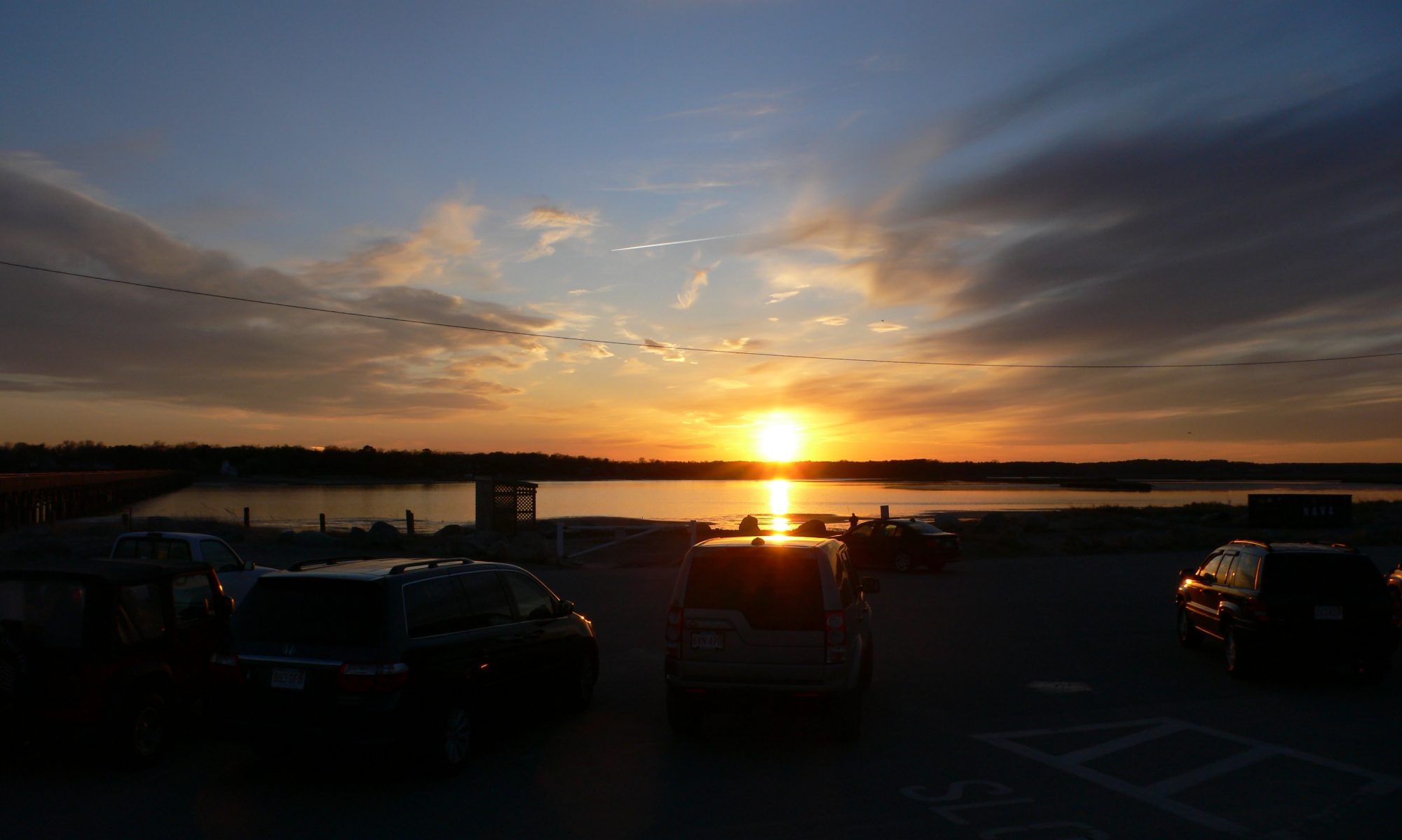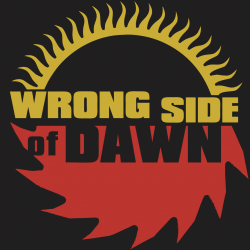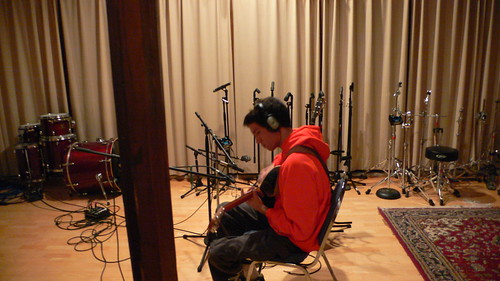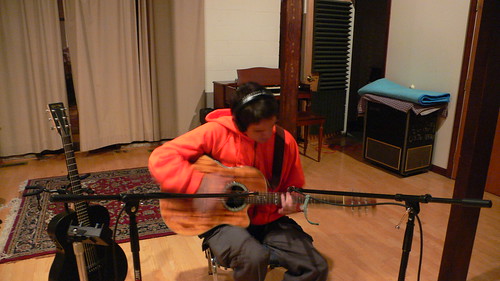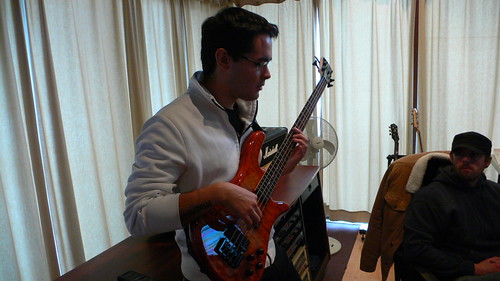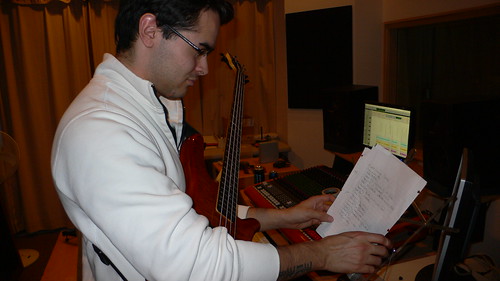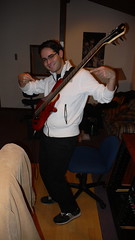Choosing a guitar
Unfortunately, choosing which guitar to record with wasn’t as easy as I hoped. All of our acoustic guitars developed problems during the record sessions, but fortunately they were different problems so we could choose which guitar to use based on which problem would affect the album the least. Now I understand why professional musicians own so many instruments: redundancy! Sure, having a selection of guitars with different properties allows you to produce a wider range of sounds, and having multiple guitars lets you quickly switch tunings while playing live, but I think the most important reason to have a lot of instruments is so you can switch when one instrument breaks down or starts sounding funny.
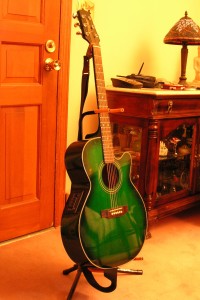 I am in love with my green Takamine acoustic-electric, named “Kermit”, and I would generally want to use it in any situation. However, recently Kermit has started going out of tune if I play high on the fretboard, and unfortunately many of our songs require me to do that. I didn’t have a chance to get Kermit’s problems checked out at the guitar store before recording started, so I had to use other guitars that were more in tune.
I am in love with my green Takamine acoustic-electric, named “Kermit”, and I would generally want to use it in any situation. However, recently Kermit has started going out of tune if I play high on the fretboard, and unfortunately many of our songs require me to do that. I didn’t have a chance to get Kermit’s problems checked out at the guitar store before recording started, so I had to use other guitars that were more in tune.
We used Brian’s black Martin acoustic-electric for a couple tracks, most notably “Running Scared”, but for some reason the low E string was sounding much louder and rattle-y than the other strings, which sounded strange. Much of “Running Scared” doesn’t use the low E string and we thought the guitar sounded fine with the parts that do, but this problem mostly eliminated the Martin from the album.
We ultimately used Brian’s Ovation acoustic-electric for most of the tracks, even though something was very wrong with the line out. I thought the line out would be important, but it turned out it wasn’t, we were able to record great-sounding acoustic guitars without it.
Recording acoustic-electric guitars without line-out
For our EP we had two tracks for each acoustic/electric guitar: a microphone in front of the sound hole, and directly plugging it into the guitar’s line out, and that delivered a decent sound. By having multiple tracks for the acoustic guitars, we can mix them together and better control the sound. For example, if the line out has more bass, and the mike over the sound hole has more treble, you can turn up the volume on the line out if you want a more bassy sound. For this album we were hoping to have three tracks for the acoustic/electrics, by adding a third track from a microphone over the fretboard. However, since the line out on the Ovation was oddly quiet and full of static, we didn’t end up using that track, so we just had two tracks, the fretboard mike and the sound hole mike. I think this gave us a deep, rich, and very acoustic sound… the line out would have made the acoustic guitars sound a bit more electric, and I’m not sure I miss it.
Surviving without heat
 We could not use the central air in the building while recording anything with microphones, because the fans made noise. It was the middle of winter in New Jersey, it was pretty darn cold outside and, without heat, inside. This problem affected recording the drums, acoustic guitars, and vocals. This may have been less of a problem for Santoro because drumming is a very physically intense activity, but playing guitar really was only exercising one or maybe two arms, there was no way I would break a sweat recording guitar. I compensated by wearing lots of layers, sometimes even wearing my winter coat indoors, and bringing a thermos of hot tea and a thermos of hot rice with me to the studio. It would have been hopeless without space heaters such as the one pictured to the left, and the little faux fireplace in the drum room, which we used to warm our fingers and maintain manual dexterity. It was still pretty miserable, but that’s the cost of the pursuing your musical dreams. If I ever get to build my own studio, I will do my best to make sure it has silent heating and cooling, so that we can keep the studio at a comfortable temperature no matter what we are recording.
We could not use the central air in the building while recording anything with microphones, because the fans made noise. It was the middle of winter in New Jersey, it was pretty darn cold outside and, without heat, inside. This problem affected recording the drums, acoustic guitars, and vocals. This may have been less of a problem for Santoro because drumming is a very physically intense activity, but playing guitar really was only exercising one or maybe two arms, there was no way I would break a sweat recording guitar. I compensated by wearing lots of layers, sometimes even wearing my winter coat indoors, and bringing a thermos of hot tea and a thermos of hot rice with me to the studio. It would have been hopeless without space heaters such as the one pictured to the left, and the little faux fireplace in the drum room, which we used to warm our fingers and maintain manual dexterity. It was still pretty miserable, but that’s the cost of the pursuing your musical dreams. If I ever get to build my own studio, I will do my best to make sure it has silent heating and cooling, so that we can keep the studio at a comfortable temperature no matter what we are recording.
My Interview
Transcript:
Brian: Um, this is the end of acoustic day… being our primary acoustic guitarist and our primary interviewer, would you like to ask yourself some questions?
Nelson: [laughter] Well, Nelson, how do you feel about being done with acoustic guitar? Well, me, I feel pretty frickin’ good. I’m sad that Kermit didn’t make it onto this album because I never got him tuned up at the shop, so Kermit is unfortunately absent. But I did enjoy the Ovation and the Martin guitars, they were good.
Brian: Did you enjoy freezing your ass off in that room over there?
Nelson: I did not enjoy freezing my ass off! Funny you should ask. But I had some hot tea and stuff, and I’m all good. I wore my orange hoodie over my headphones, so I was nice and cozy. It’s an accomplishment! I am happy.
Brian: One of your standard questions has been your favorite and least favorite songs to record.
Nelson: I think that Flight III / Flight I came out really good, I’m really proud of that. I am not proud of how I couldn’t play the finger-picking to “Out of Time” despite having practiced it for like years on end. But Brian hit it so it’s all good. And you know, I’ll practice it more and someday we’ll play it live, so… I am satisfied.
Brian: Alright, to be continued.
Nelson: Thank me for the interview 😉
